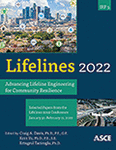Telecommunication Performance during Puebla Earthquake M7.1, 19 September 2017
Publication: Lifelines 2022
ABSTRACT
The 2017 earthquake in Central Mexico (epicenter East of Ayutla, Mexico Earthquake) that terrorized Mexico City and Puebla occurred on the same month and day as the 1985 Michoacan, Mexico earthquake, which caused significant damage to lifelines in Mexico City. The official name of this earthquake is Puebla Earthquake. The differences between these two earthquakes are locations of the epicenter, the duration of strong shaking, and most importantly the magnitude. The 2017 earthquake epicenter was located about 150 km south-east of Mexico City, it happened at 13:14 local time and the magnitude was 7.1 with a duration of about 60 ss of strong motion. The 1985 earthquake epicenter was located about 330 km south of Mexico City, it happened at 07:17 local time and the magnitude was 8.0 with duration of 90 s of strong motion. Thus, all lifelines in Mexico City and areas around Puebla sustained various degrees of damage and service interruption. Electric power system experienced the most disruptions due to both substation damage and distribution system failures. Although the telecommunication system did not sustain much damage, the power system failures did cause some telecom service interruptions in areas with long duration power outages. Cellular messaging applications on smart phones reportedly were performing well when the voice call lines were saturated during the first day after the earthquake. There were scattered roads and bridges failures and also broken underground water pipelines. There was a report of liquid fuel tank failure but there was no report of cascade damage due to the tank failure. The airport was closed for a short time and there was a short section of the road around the airport terminal that cracked due to ground failure. Very minor damage was observed in the international airport terminal. There were also building failures and collapses including part of a school building. There were incidents of fire with one fire caused by gas tank explosion. Emergency services performed well. Therefore, lessons learned from the 1985 earthquake probably contributed to overall better telecommunication lifeline performance. There was no report of Central Office (CO) failures.
Get full access to this article
View all available purchase options and get full access to this chapter.
REFERENCES
SGS earthquake information Mexico City. 2017. https://earthquake.usgs.gov/earthquakes/eventpage/us2000ar20#region-info.
USGS earthquake information Mexico City. 1985. https://earthquake.usgs.gov/earthquakes/eventpage/usp0002jwe/executive.
Kwasinski, A., and Krishnamurthy, V. “Generalized Integrated Framework for Modeling Communications and Electric Power Infrastructure Resilience,” in Proc. INTELEC 2017, pp. 1–8, Gold Coast, Australia, October 2017.
Marnay, C., Aki, H., Hirose, K., Kwasinski, A., Ogura, S., and Shinji, T. “Japan’s Pivot to Resilience: How Two Microgrids Fared After the 2011 Earthquake,” IEEE Power and Energy Magazine, vol. 13, no. 3, pp. 44–57, May/June 2015.
Information & Authors
Information
Published In
History
Published online: Nov 16, 2022
Authors
Metrics & Citations
Metrics
Citations
Download citation
If you have the appropriate software installed, you can download article citation data to the citation manager of your choice. Simply select your manager software from the list below and click Download.
